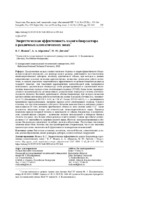| dc.contributor.author | Исаков, В. Г. | |
| dc.contributor.author | Абрамова, А. А. | |
| dc.contributor.author | Дягелев, М. Ю. | |
| dc.coverage.spatial | Минск | ru |
| dc.date.accessioned | 2020-08-07T11:01:54Z | |
| dc.date.available | 2020-08-07T11:01:54Z | |
| dc.date.issued | 2020 | |
| dc.identifier.citation | Исаков, В. Г. Энергетическая эффективность малого биореактора в различных климатических зонах = Energy Efficiency of a Small Bioreactor in Various Climatic Zones / В. Г. Исаков, А. А. Абрамова, М. Ю. Дягелев // Энергетика. Известия высших учебных заведений и энергетических объединений СНГ. – 2020. – № 4. – С. 355-364. | ru |
| dc.identifier.uri | https://rep.bntu.by/handle/data/77507 | |
| dc.description.abstract | Предложенная модель оценки теплового баланса и энергоэффективности биореактора позволяет определить для реактора малого размера, работающего на относительно низкоэнергетическом субстрате, величину критического объема, при котором в данных климатических условиях возможна круглогодичная, полностью автономная работа метан-тенка, и оценить вероятную энергетическую эффективность подобного биореактора (выход товарной теплоты). Для численной характеристики климатической зоны предлагается использовать среднегодовую температуру и/или распространенный в строительной тепло-технике показатель градусо-суток отопительного периода (ГСОП), более полно характеризующего неравномерность среднемесячного распределения температур (степень континентальности климата). Величина критического объема биореактора, при котором возможна круглогодичная автономная работа метантенка на осадке городских сточных вод, изменяется от 7,5 (Владикавказ, ГСОП = 3410) до 17,0 м3 (Томск, ГСОП = 6938), т. е. увеличивается практически пропорционально значению градусо-суток отопительного периода. Следует отметить, что при использовании субстрата с большим выходом биогаза, например свиного навоза (выход 40 г/кг), величина критического объема во всех случаях менее 1 м3. Такие результаты актуальны только для относительно низкоэнергетического сырья. Характер изменения выхода товарной теплоты в зависимости от объема биореактора и климатических условий вполне ожидаем – количество полезно используемой в интересах бизнеса теплоты тем выше, чем больше объем реактора и мягче климат. Однако при объеме реактора менее 5 м3 нелинейность графиков намного выше. Поэтому для проектировщиков особо малых биореакторов проведение подобных расчетов обязательно. Полученные численные значения могут быть полезны как для проектировщика биореакторов, так и для заказчика проекта при оценке экономической эффективности планируемых нововведений. | ru |
| dc.language.iso | ru | ru |
| dc.publisher | БНТУ | ru |
| dc.title | Энергетическая эффективность малого биореактора в различных климатических зонах | ru |
| dc.title.alternative | Energy Efficiency of a Small Bioreactor in Various Climatic Zones | ru |
| dc.type | Article | ru |
| dc.identifier.doi | 10.21122/1029-7448-2020-63-4-355-364 | |
| local.description.annotation | The authors proposed a model for estimating the heat balance and energy efficiency of a bioreactor that makes possible for a small-sized reactor operating on a relatively low-energy substrate to determine the critical volume, under which the existing climatic conditions allow year-round fully autonomous operation of the digester, as well as for evaluation the potential energy efficiency of such a bioreactor (output commodity heat). For the numerical characteristics of the climatic zone, it is proposed to use the average annual temperature and/or the “degree-day of the heating period” (DDHP) indicator common in construction heat engineering; the DDHP value more adequately characterizing the unevenness of the average monthly temperature distribution, i.e. degree of climate continentality. At the same time, the value of the critical volume of the bioreactor, at which year-round autonomous operation of the digester operating on the municipal sewage sludge, is possible, varies from 7.5 (Vladikavkaz, DDHP = 3410) to 17.0 m3 (Tomsk, DDHP = 6938), i. e. increases almost in proportion to the degree-day of the heating period. It should be noted that when using a substrate with a high biogas yield, e. g., pig manure (a biogas yield of 40 g/kg is adopted), the critical volume in all cases is less than 1 m3. Such results are relevant only for relatively low-energy raw materials. The nature of changes in the output of commodity heat, depending on the volume of the bioreactor and climatic conditions, is quite expectable, viz. the amount of heat that is useful for business interests is higher, the higher is the reactor volume and the milder is the climate. However, when the reactor volume is less than 5 m3, the non-linearity of the graphs is much higher, i. e. for a designer of especially small bioreactors, it seems mandatory to carry out such calculations. The obtained numerical values can be useful both for the designer of bioreactors and for the customer of the project when evaluating the economic efficiency of the planned new innovations. | ru |

